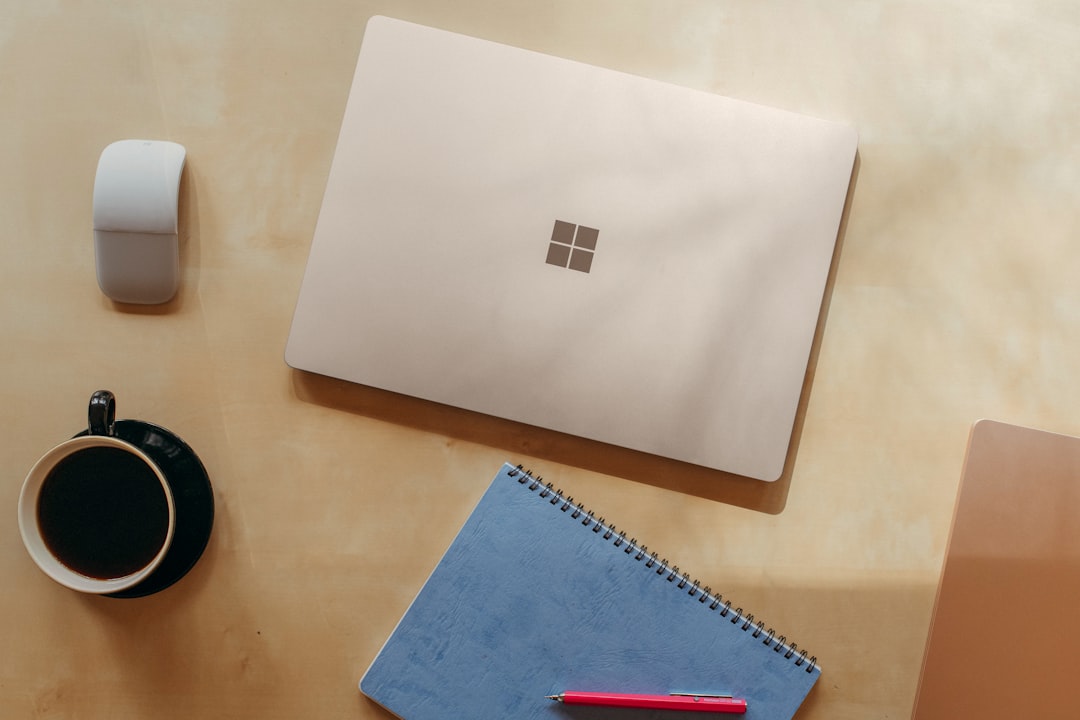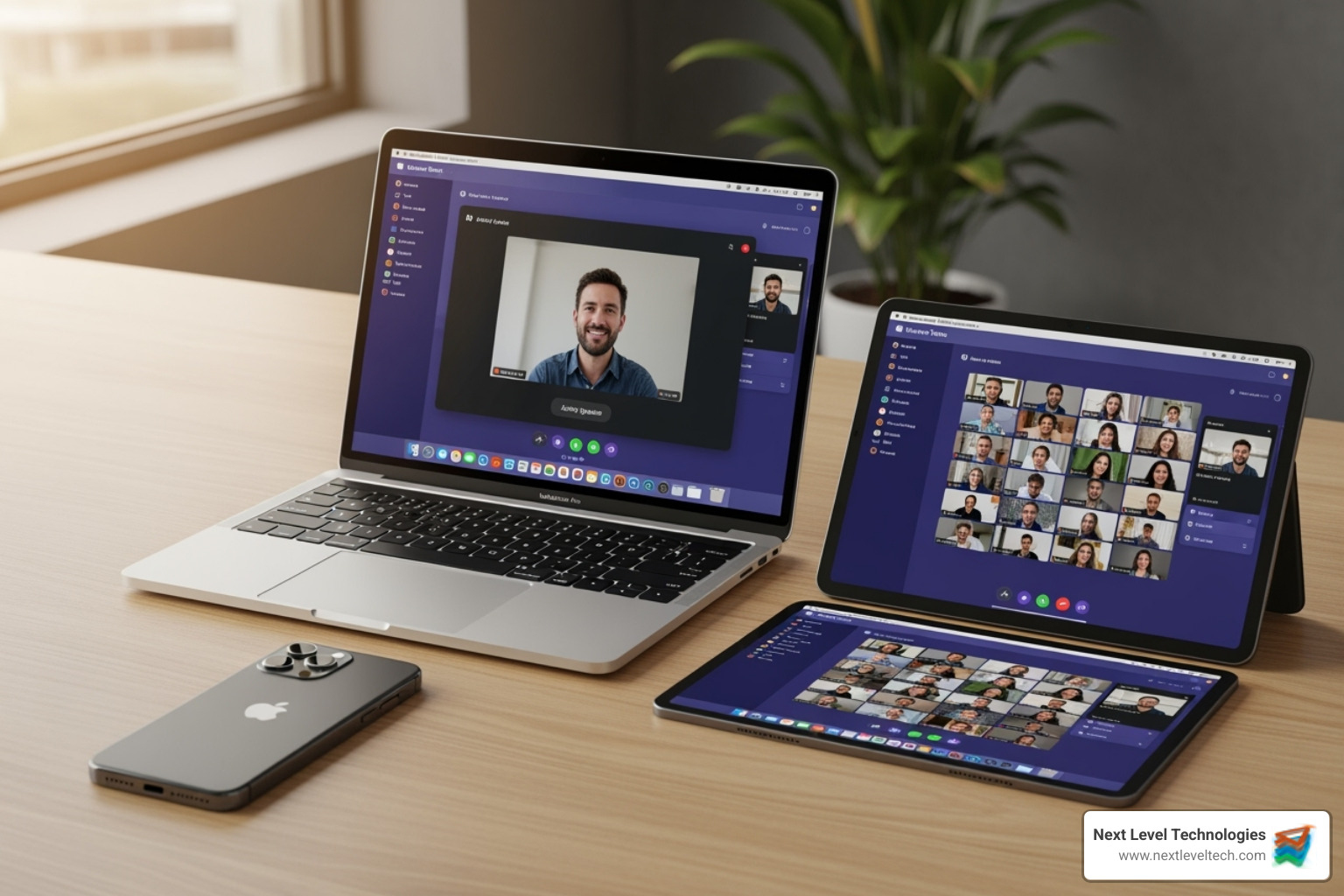Working Remotely at Microsoft: Your Guide to Flexible Careers
November 21, 2025

Unlock microsoft work from home insights. Learn about their hybrid model, technology, and flexible career paths for employees.
November 21, 2025

Find expert IT Service Providers in Columbus Ohio. Secure your business, optimize tech, and drive growth with a trusted local partner.
November 20, 2025

Explore how cloud computing healthcare revolutionizes patient care, secures data, and boosts efficiency. Your guide to digital transformation.
November 19, 2025
November 21, 2025
Microsoft work from home policies have become a blueprint for flexible employment in the tech industry. After transitioning tens of thousands of employees to remote work during COVID-19, Microsoft has evolved into a hybrid-first company that balances employee flexibility with business collaboration needs.
Current Microsoft Remote Work Policy:
The shift reflects broader workplace trends. Microsoft's 2022 Work Trend Index found 51% of hybrid employees are likely to go fully remote, and over half of all employees now prioritize wellbeing and work-life balance above work.
Microsoft's approach centers on what they call "intentional and impactful in-person time" while maintaining the flexibility employees demand. Their 97% cloud migration of internal applications and comprehensive Zero Trust security model enable seamless remote collaboration through tools like Teams, SharePoint, and OneDrive.
The company frames this evolution around the "AI era," where meaningful breakthroughs happen through real-time collaboration. As Microsoft leadership notes: "When people work together in person more often, they thrive - they are more energized, empowered, and they deliver stronger results."
I'm Steve Payerle, President of Next Level Technologies, and I've helped businesses across Columbus, Ohio and Charleston, WV implement secure microsoft work from home solutions similar to Microsoft's model. My team's extensive cybersecurity training ensures companies can adopt flexible work policies without compromising data security or operational efficiency.

When COVID-19 hit in early 2020, Microsoft work from home wasn't just a policy change—it was a complete change of how one of the world's largest tech companies operated. Like many organizations, Microsoft had to pivot overnight, moving tens of thousands of employees from busy office spaces to home offices around the globe.
What started as an emergency response quickly became something much more strategic. Microsoft didn't just react to the pandemic; they studied it, learned from it, and used those insights to redesign their entire approach to work.

Before the pandemic, Microsoft accepted some flexibility, but its current "Hybrid Workplace" model is on another level. It emerged from careful data collection and employee feedback to understand what truly worked.
This data-driven approach led to something unique: manager discretion as a core principle. Rather than imposing a one-size-fits-all solution, Microsoft empowers individual teams to tailor their work arrangements based on specific needs while following broader company guidelines.
Microsoft created clear work site definitions, from fully remote ("0 days / week in-office") to fully on-site, with hybrid options in between. This nuanced approach recognizes that different roles have different needs. You can explore the details in Microsoft's official guidance on flexible work.
Those first few months of 2020 were a scramble for everyone. Microsoft employees from Milan to their Puget Sound campus suddenly found themselves working from kitchen tables and makeshift home offices. But here's where it gets interesting—Microsoft turned this challenge into an opportunity.
They became their own best customer, using Microsoft Teams, SharePoint, and their entire suite of tools to maintain productivity. This "eating your own dog food" approach helped them refine their products while learning what truly worked for remote collaboration.
As the immediate crisis passed, Microsoft shifted from simply enabling remote work to intentionally designing it. Their employee data revealed something fascinating: while people loved the flexibility of remote work, in-person collaboration still played a crucial role in innovation and team bonding.
This led to what Microsoft calls the "productivity paradox." Individual productivity often soared when people worked from home, but collaborative innovation sometimes suffered. The challenge became clear: how do you capture the best of both worlds?
Microsoft's research showed that when people worked together in person more frequently, they were more energized, empowered, and delivered stronger results. This insight became the foundation for their permanent hybrid model—one that balances individual flexibility with collective success.
Microsoft's current three-day-a-week expectation isn't arbitrary. It's rooted in their belief that meaningful breakthroughs, especially in our rapidly evolving AI era, happen when people can build on each other's ideas in real-time.
The company sees face-to-face collaboration as essential for innovation, allowing for spontaneous conversations and real-time energy that drives business forward.
But Microsoft isn't rushing this transition. Their phased rollout starts with employees living within 50 miles of their Puget Sound campus, who are expected to be onsite three days a week by February 2026. Plans for other U.S. and international locations will follow, with timelines that acknowledge the diverse needs of their global workforce.
This measured approach shows Microsoft's commitment to balancing the collaborative benefits of in-person work with the flexibility that employees have come to value. It's not about returning to the old ways—it's about creating something entirely new.
As someone who's helped businesses in Columbus, Ohio and Charleston, WV implement secure remote work solutions, I've seen how this kind of thoughtful, data-driven approach to hybrid work can transform organizations while maintaining the security and collaboration they need to thrive.
When you peek behind the curtain of Microsoft work from home success, you'll find a technology foundation that was decades in the making. Microsoft didn't just get lucky when the world went remote overnight. Their cloud-first strategy, which they'd been quietly building for years, suddenly became their secret weapon.
An impressive 97% of Microsoft's internal applications were already on the cloud before the pandemic. While others scrambled to provide remote file access, Microsoft employees were already cloud-native.
Cloud migration is only half the battle; security is the other. Microsoft's Zero Trust model operates on the principle of "trust no one, verify everything." It assumes no implicit trust and verifies every access request, regardless of origin.
This approach of "eating your own dog food" – using their own products internally – has made Microsoft incredibly good at understanding what actually works in the real world. When we help businesses in Columbus, Ohio, and Charleston, WV, set up their own remote work systems, we often point to Microsoft's playbook. Our cybersecurity-trained team has seen how these Secure Remote Access Solutions can transform how companies operate.
The success of Microsoft work from home relies on a suite of integrated technologies. Here are the key players:

Microsoft Teams is the central hub for communication and collaboration, handling everything from chats to video conferences. It integrates with other tools, creating a natural virtual office. We often help businesses Make Working or Collaborating Easier with Microsoft Teams.
Microsoft 365 brings all those familiar Office apps – Word, Excel, PowerPoint, Outlook – right to wherever employees happen to be working. Whether they're on their laptop, tablet, or phone, everything syncs perfectly. Multiple people can edit the same document at the same time without anyone losing their work or stepping on each other's toes.
OneDrive has essentially eliminated the phrase "I left that file at the office." Every document, spreadsheet, and presentation lives in the cloud, accessible from anywhere. Employees save files just like they always have, but now those files follow them wherever they go.
SharePoint acts as the company's intelligent brain, organizing information so it's actually findable. Microsoft has moved all their major intranet portals and Team sites to SharePoint in Microsoft 365, with over 90% using modern templates that make everything look clean and work smoothly. No more digging through endless folders to find what you need.
Azure is the foundation that holds everything together. It's the cloud platform that ensures all these tools work reliably, whether you have 10 employees or 10,000. Microsoft moved most of their legacy applications to Azure, which means everything runs fast and stays available, even when everyone's working from home.
Windows Virtual Desktop is the secret weapon for employees who need heavy-duty computing power or specialized software. Developers and other technical folks can access powerful virtual machines from anywhere, making it feel like they have a supercomputer sitting on their kitchen table.
That 97% cloud migration statistic is changeal. It's why we confidently recommend Cloud Computing for Businesses to our clients, having seen how this approach can change how companies operate.
Microsoft's work-from-home strategy prioritizes making remote work both secure and productive. The company's approach to security is rigorous, as it should be in today's environment.
The Zero Trust security principles are simple: assume every access request is a threat until proven otherwise. Regardless of location—office, home, or coffee shop—every connection undergoes rigorous verification. This proactive stance is essential for modern data security.
Multi-factor authentication (MFA) is absolutely non-negotiable at Microsoft. Whether it's a smart card, fingerprint, PIN, or phone app, employees always need that second layer of verification. We tell our clients all the time: using just a password these days is like locking your front door but leaving all the windows wide open.
Microsoft Endpoint Manager (MEM) keeps track of every device that connects to company resources. Windows computers, Macs, phones, tablets – everything gets managed from one central location. This means IT can push out security updates, enforce policies, and make sure every device meets security standards before it can access anything important.
The device health verification component is particularly clever. Before any device can connect, the system checks to make sure it's healthy, up-to-date, and compliant with security policies. It's like having a security guard who actually checks IDs instead of just waving people through.
Service monitoring happens around the clock. Microsoft's IT team watches performance metrics and user satisfaction scores like hawks, catching problems before they become real headaches for employees. This proactive approach means issues get fixed before most people even notice them.
Data protection is woven into everything. Files automatically get classified and protected based on how sensitive they are. Regional data requirements get handled automatically, so companies don't have to worry about accidentally storing data in the wrong country.
Our cybersecurity-trained staff at Next Level Technologies brings this same level of attention to security for businesses in Columbus, Ohio, and Charleston, WV. We've put together an IT Security Services Ultimate Guide that breaks down these complex security concepts into manageable pieces. Because at the end of the day, security shouldn't be something that keeps you up at night – it should be something that lets you sleep better.
Balancing employee wants with business needs is a challenge, but Microsoft's flexible approach—built on trust, autonomy, and clear accountability—has proven effective. They've found that when people feel ownership over their work, everyone wins.

The numbers from Microsoft's 2022 Work Trend Index report tell a compelling story. 51% of current hybrid employees say they're likely to go fully remote in the coming year. This isn't just about avoiding traffic jams - it reflects a fundamental shift in what people value most.
The top reasons employees left their jobs in 2020-2021 were personal wellbeing and work-life balance. Today, more than half of workers prioritize their health and wellbeing over work itself - a dramatic change from pre-pandemic thinking. Microsoft recognized this shift early and built their microsoft work from home strategy around it.
Their solution? What they call "intentional and impactful in-person time." Instead of requiring people to be in the office just because, they focus on making sure time together serves a real purpose. Whether it's brainstorming breakthrough ideas, building team connections, or tackling complex projects that benefit from face-to-face collaboration, every office day should count.
This approach gives managers the flexibility to work with their teams and find the right balance for their specific needs. Some teams might need more in-person time for creative work, while others can thrive with minimal office requirements.
The microsoft work from home model delivers real advantages that directly address what today's workforce values most.
Reduced commute time offers more than just convenience. The hours saved can be reinvested in family, hobbies, exercise, or rest, significantly improving quality of life.
Better work-life integration has become a game-changer. Need to pick up your kids from school? Schedule a doctor's appointment? Fit in that workout that keeps you energized? Remote and hybrid work makes these everyday needs much easier to manage without sacrificing professional responsibilities.
Increased focus is another unexpected benefit. Many people find their home environment offers fewer distractions than a busy office. When you need to dive deep into complex work, having a quiet, controlled space can boost both productivity and job satisfaction.
Career growth opportunities have expanded dramatically. Talented professionals can now consider positions with companies like Microsoft without relocating their entire lives. This geographic flexibility opens doors that simply didn't exist before, while companies benefit from access to a much broader talent pool.
At Next Level Technologies, we've helped businesses across Columbus, Ohio, and Charleston, WV, implement similar flexible work models. Our guide on 3 Ways to Seamlessly Manage Working Remotely and From Your Workplace draws lessons from industry leaders like Microsoft to help companies create their own successful hybrid strategies.
Even the best microsoft work from home approach comes with its own set of challenges. The good news? Microsoft has identified these issues and developed practical solutions.
Meeting fatigue tops the list of complaints. When every conversation moves to video calls, people quickly burn out from being "on camera" constantly. Microsoft addresses this by encouraging smarter meeting practices and using features like live events for large-scale communications, so not everyone needs to be actively participating in every update.
Maintaining company culture becomes trickier when your team is scattered across different locations. Microsoft tackles this challenge by leveraging their own tools - Yammer for social connections, live events for company-wide communications, and creative initiatives like their 18-hour global "chasing the sun" event that connected employees across time zones.
Ensuring equity between remote and in-office employees requires constant attention. It's easy for leaders to unconsciously favor the people they see every day. Microsoft works hard to create systems where location doesn't determine opportunity or inclusion.
Digital exhaustion affects people differently, but the constant connectivity can be draining. Microsoft's emphasis on work-life balance and tools that streamline rather than complicate work helps address this growing concern.
Leadership visibility presents unique challenges when teams are distributed. Leaders need to be more intentional about communication and connection. Microsoft uses their own platform to ensure leadership remains accessible and engaged, regardless of physical location.
Microsoft combats these challenges with targeted strategies: Microsoft Viva Insights encourages healthy work habits, asynchronous communication is promoted via shared documents and recorded meetings, and manager training focuses on leading hybrid teams effectively. Inclusive meeting design also ensures remote participants are fully engaged.
These proactive measures show Microsoft's commitment to making their hybrid model work for everyone. At Next Level Technologies, our cybersecurity-trained staff helps businesses implement similar comprehensive approaches, ensuring that flexibility never comes at the cost of security or productivity.
If you're considering a career at Microsoft or simply curious about how they handle microsoft work from home arrangements, you're not alone. These are the questions we hear most often from professionals exploring flexible work opportunities.
Microsoft's current approach is a hybrid model, typically requiring employees to be in the office three days per week. However, this is not a rigid, one-size-fits-all policy. The actual requirements can vary significantly depending on your specific team, role, and projects.
Manager-led decisions play a huge part in how this flexibility works day-to-day. Your team lead has the discretion to adjust expectations based on what makes sense for your group's collaborative needs and business goals. This means some teams might need more face-to-face time during product launches, while others might function perfectly well with minimal in-person interaction.
When you're job hunting at Microsoft, pay close attention to the "work site" designation in each posting. This will tell you exactly what to expect - whether it's 0, 1, 2, 3, or more days per week in the office. For employees living within 50 miles of the Puget Sound campus, the three-day expectation will be fully rolled out by February 2026, with other locations following suit.
The short answer is yes, for certain roles. When browsing Microsoft's job listings, you'll occasionally find positions marked with a "0 days / week in-office - remote" designation. These are genuinely remote positions where you won't be expected to show up at an office regularly.
However, there's an important catch to keep in mind. These remote roles are typically available only within specific countries where Microsoft is authorized to employ people. So while you might work from your home office, you'll still need to live in a location where Microsoft can legally hire you. The availability really depends on the specific job posting and what the hiring team needs.
It's worth checking job descriptions carefully, as remote availability can vary significantly between different departments and roles within the company.
Microsoft's support for remote workers is pretty comprehensive, and it starts with their technology suite. Remote employees get access to the full Microsoft ecosystem - Teams for communication and collaboration, Microsoft 365 for all your productivity needs, OneDrive for cloud storage, and SharePoint for accessing company resources. It's essentially like having a complete virtual office at your fingertips.
But the support goes well beyond just handing you the right software. Microsoft has built a culture of trust and flexibility where employees are expected to manage their work effectively while staying aligned with team goals. This means you're trusted to figure out when and how you work best, as long as you're delivering results.
Manager support is another crucial piece. Microsoft trains its managers specifically on how to lead hybrid teams effectively. This ensures that remote employees don't get left out of important decisions, growth opportunities, or team dynamics just because they're not physically present.
Finally, Microsoft provides extensive resources for wellbeing and productivity. This includes everything from guidance on setting up an effective home workspace to strategies for managing digital fatigue and maintaining a healthy work-life balance. Their internal communities and resources offer practical tips for thriving in a remote environment.
At Next Level Technologies, we've helped businesses in Columbus, Ohio and Charleston, WV implement similar comprehensive remote work support systems. Our cybersecurity-trained team understands that successful microsoft work from home models require both the right technology foundation and the proper security measures to protect sensitive business data.
Microsoft's journey with microsoft work from home and hybrid work models tells a story that resonates with businesses everywhere. What started as an emergency response to a global pandemic has evolved into something much more thoughtful - a carefully crafted approach that puts both people and productivity at the center.
Their data-driven evolution shows us that the future of work isn't about picking sides between remote or in-office. Instead, it's about creating intelligent systems that adapt to what employees actually need while still driving the collaboration and innovation that businesses require. Microsoft's commitment to balancing flexibility with meaningful collaboration has created a blueprint that many organizations are now following.
The technology foundation they've built - with their cloud-first strategy, Zero Trust security model, and comprehensive suite of collaboration tools - proves that secure, productive remote work is absolutely achievable. When 97% of your applications live in the cloud and every access request is verified through Zero Trust principles, geography becomes much less of a barrier to great work.
What impresses me most about Microsoft's approach is how they've used their own experiences to constantly refine their model. They're not just implementing policies; they're learning, adapting, and improving based on real employee feedback and productivity data. This kind of intentional design thinking is what separates successful flexible work programs from those that struggle.
For businesses across Columbus, Ohio, and Charleston, WV, this Microsoft model offers real hope and practical direction. The reality is that employees now expect flexibility - and companies that can't provide it risk losing great talent to those who can. But flexibility without security is a recipe for disaster, which is why the cybersecurity expertise my team brings to the table is so crucial.
At Next Level Technologies, we've helped numerous businesses build secure, flexible IT infrastructures that rival what Microsoft has created for themselves. Our extensively trained cybersecurity team understands that enabling remote work isn't just about providing laptops and VPN access - it's about creating comprehensive, secure systems that protect your data while empowering your people to do their best work from anywhere.
The future of work is here, and it looks a lot like what Microsoft has built. If you're ready to give your team the flexibility they want while maintaining the security your business needs, we'd love to help you create your own success story. Learn more about our Managed IT Services and IT Support and let's build your future of work together.
Find expert IT Service Providers in Columbus Ohio. Secure your business, optimize tech, and drive growth with a trusted local partner.
November 20, 2025
Explore how cloud computing healthcare revolutionizes patient care, secures data, and boosts efficiency. Your guide to digital transformation.
November 19, 2025
Next Level Technologies was founded to provide a better alternative to traditional computer repair and ‘break/fix’ services. Headquartered in Columbus, Ohio since 2009, the company has been helping it’s clients transform their organizations through smart, efficient, and surprisingly cost-effective IT solutions.
